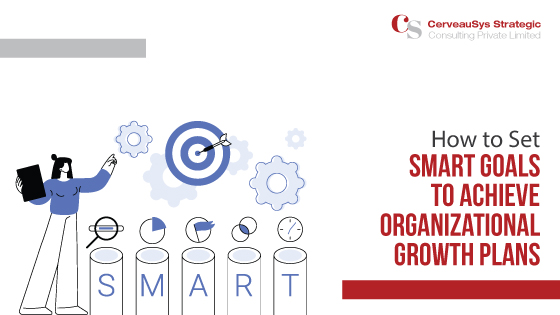How to Set SMART Goals to Achieve Organizational Growth Plans
The concept of SMART goals has been a cornerstone for effective planning and implementation within successful organizations. The acronym stands for Specific, Measurable, Achievable, Relevant, and Time-bound, and it offers a structured approach to setting and reaching objectives. By understanding and applying the SMART framework, companies can align their strategic goals with their growth plans, propelling them toward successful outcomes. SMART goals not only clarify direction but also motivate and engage the team fully.
At CerveauSys Strategic, we say that SMART goals not only clarify direction but also motivate and engage the team fully. Let us help you delve deeper into how SMART goals can be set and the common challenges organizations face in this process.
Understanding SMART Goals for Organizations
1) S- Specific Goals
A clear and specific goal serves as a guidepost for organizations, providing clarity and direction. A specific goal is concise and answers the “W” questions: Who is involved? What do we want to accomplish? Where will it take place? When is the deadline? Why is the goal important? By clearly defining these elements, teams can focus their efforts and utilize resources more efficiently. Specific goals help eliminate ambiguity, facilitating a straightforward path to follow and ensuring all stakeholders are on the same page. This precision minimizes misunderstandings and galvanizes collective action towards the desired outcome.
2) M- Measurable Goals
Measurable goals enable organizations to track their progress and assess the success of their strategies. By establishing criteria for measuring progress, companies can determine how well they are moving toward their goals. Measurement often involves quantitative considerations such as numbers, frequencies, or percentages.
By identifying key performance indicators (KPIs) early on, teams can stay informed of their progress and make necessary adjustments in real time. This measurable aspect fosters accountability and motivates employees to achieve desired outcomes. Transparent metrics encourage informed decision-making and facilitate performance assessment across the board.
3) A- Achievable Goals
Setting achievable goals requires a realistic assessment of the organization’s capabilities and resources. Goals should stretch an organization’s abilities but remain within the realm of possibility. Achievability ensures that goals are not set so high that they become discouraging, nor so low that they do not require effort.
By considering existing constraints and resources, organizations can ensure that their goals are challenging but attainable. This boosts the morale of the team as they see tangible progress being made. Achievable goals cultivate a culture of success, fostering confidence in the organization’s strategic direction.
4) R- Relevant Goals
Relevant goals align with broader business objectives and resonate with an organization’s vision and mission. They must be pertinent to achieve long-term and short-term objectives and should hold significant value. When goals are relevant, they tend to engage stakeholders more effectively, as achieving them contributes to the larger picture of the organization’s success.
Relevance ensures that all goals are impactful and contribute meaningfully toward strategic initiatives without diverting attention from critical engagements. A focus on relevance prevents wasteful initiatives and drives coordinated efforts aligned with core organizational values.
5) T- Time-bound Goals
Time-bound goals emphasize the importance of setting deadlines for goal achievement. Time constraints create a sense of urgency and encourage focused effort. By specifying a timeframe, organizations can prioritize their actions and allocate resources effectively. Deadlines prevent procrastination and sustain momentum throughout the execution of a strategy.
Setting time-bound constraints ensures that there’s a clear timeline for achieving milestones, facilitating the structured deployment of strategies. Having distinct timeframes enhances project control and resource management, guiding timely accomplishment of objectives.
Top Challenges in Setting SMART Goals
Despite the clear framework, several challenges may restrict the application of SMART goals within an organization.
Ambiguity in Goal Setting
One of the primary challenges lies in articulating goals with utmost clarity. Ambiguity can lead to confusion, resulting in misaligned efforts and wasted resources. It is vital for organizations to spend time refining and articulating the specific details of each goal, ensuring stakeholders understand them. Clear communication regarding goals eliminates vagueness, channeling focused efforts towards their attainment.
Lack of Measurement Tools
Without proper measurement tools and data analytics, tracking progress can be challenging. Organizations should invest in tools that provide clear metrics and allow them to measure success accurately. This ensures that progress is tangible and based on verifiable data. Mechanisms for quantitative tracking uphold transparency and fortify performance evaluation processes.
Overambitious Goals
Organizations sometimes set overly ambitious goals that may stretch their capacities. Failing to balance aspiration with realistic capabilities can demotivate teams when goals are not achieved. Therefore, understanding organizational limitations and prioritizing achievable goals is essential. Striking a balance between ambition and feasibility engenders sustainable progress, nurturing team motivation.
Misalignment with Business Objectives
Misalignment with larger business objectives can render goals ineffective. Every goal must contribute pertinently to the wider strategic objectives of the organization. Ensuring relevance across all levels of planning keeps teams focused and driven toward meaningful achievement. Aligning goals with the organizational mission enhances coherence and maximizes strategic impact.
Time Management Issues
Without effective time management, meeting time-bound goals becomes an uphill task. Unforeseen delays, lack of resource allocation, and uncoordinated efforts can derail timelines, thwarting progress. Cultivating disciplined timelines and consistency in approach is key. Adequate preparation and resource planning fortify time-sensitive execution, preventing unnecessary setbacks.
Set Your Organization’s SMART Goals with CerveauSys Strategic
Setting SMART goals is crucial for organizations aiming for structured growth and success. Understanding and addressing each component—Specific, Measurable, Achievable, Relevant, and Time-bound—while navigating common challenges, enables organizations to build robust strategies and achieve desired outcomes. Strategic goal setting provides clarity, motivation, and focus, fostering a pathway to sustained organizational success.
To amplify your strategic performance improvements, choose CerveauSys Strategic, the premier Strategy and Management Consulting firm in Pune. Our unparalleled expertise in business strategy, HR, and OD consulting guarantees consistent and efficient results for your organization. With CerveauSys by your side, unlock your full potential, realize your growth ambitions, and flourish in today’s competitive landscape. Leveraging our goal-setting prowess positions your organization for optimal success, transforming aspirations into remarkable achievements.
Contact us today to discuss how we can tailor strategies to meet your unique business needs and drive your organization towards exceptional growth.



